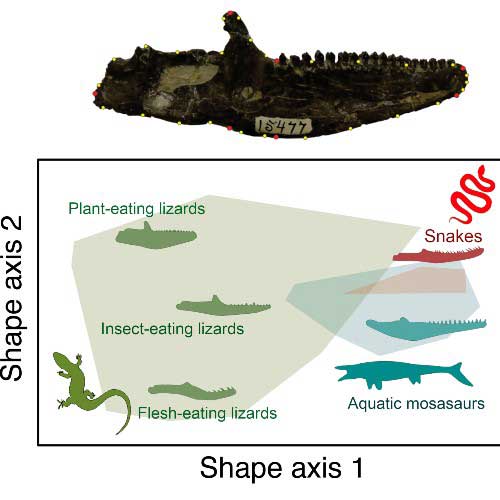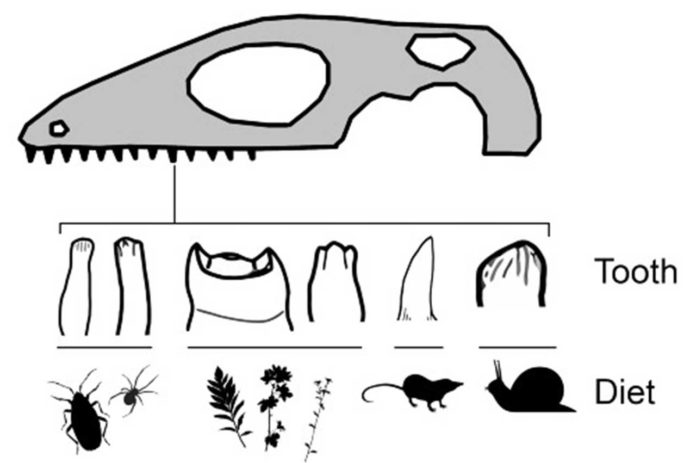Squamates (lizards and snakes) are highly successful modern vertebrates, with over 10,000 species. With a long history, dating back to at least 240 million years ago- they show increasing species richness in the Late Cretaceous (84 Ma) and early Paleogene (66–55 Ma).
A recent study by the University of Bristol shed light on the diets of these Squamates. Scientists found that the diets of early lizards and snakes were more varied and advanced than previously thought.
Scientists studied 220 Mesozoic squamates- including lizards, snakes, and mosasaurs. Mosasaurs are a group of extinct large marine reptiles. They measured their jaws and teeth and allocating them to dietary classes by comparison with modern forms. Some have long peg-like teeth and feed on insects; others have flat teeth used for chopping plant food. Predators have sharp, pointed teeth, and snakes have hooked teeth to grasp their prey.
All the fossil forms were allocated to one of eight feeding categories, and then their diversity through time was assessed. Scientists were surprised after finding that the rather sparse Cretaceous squamates included examples of all modern feeding strategies.

Lead author Dr. Jorge Herrera-Flores, who is now a Research Fellow at the National Autonomous University of Mexico, said, “We don’t know for sure how diverse squamates were in the Cretaceous. But we do know they had already achieved the full modern-type diversity of feeding modes by 100 million years ago, in the middle of the Cretaceous. Before that, squamates had already existed for more than 100 million years, but they seemed to be mainly insect-eaters up to that point.”
Co-author Dr. Tom Stubbs, Senior Research Associate at the University of Bristol School of Earth Sciences, said, “Studying teeth and jaws provide excellent insights into dietary and ecological variety. Fossil teeth and jaws give us the best insight into squamate evolution in the past. It would be easy to misread the fossil record because of incomplete preservation. However, more fossil finds could only increase the number of feeding modes we identify in the Cretaceous, not reduce them.”
Co-author Professor Michael Benton, Professor of Vertebrate Palaeontology at the School of Earth Sciences, said, “The Cretaceous Terrestrial Revolution made forests more complex. The new flowering plants provided insects and other creepy crawlies to feed on leaves, pollen, and nectar and to hide in the canopy. This burst of diversity likely gave a stimulus to mammals, birds, and squamates, all of which diversified about this time, probably feeding on the insects, spiders and other bugs, as well as on the new plant food.”
The new work does not provide the single reason why squamates are so diverse today – nearly as diverse as birds. However, it shows that their ancestors had already explored all the likely feeding niches 100 million years ago before the dinosaurs died out.
Journal Reference:
- Jorge Alfredo A Herrera Flores et al. Ecomorphological diversification of squamates in the Cretaceous. DOI: 10.5061/dryad.f1vhhmgvw
